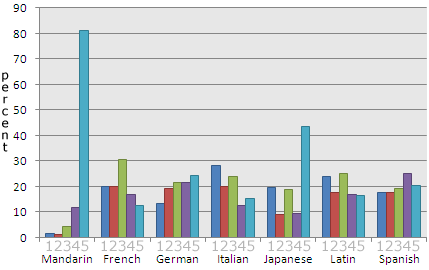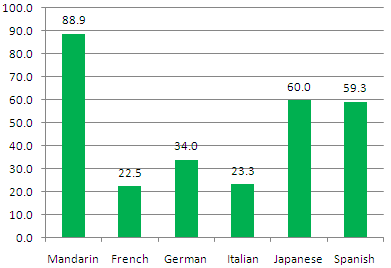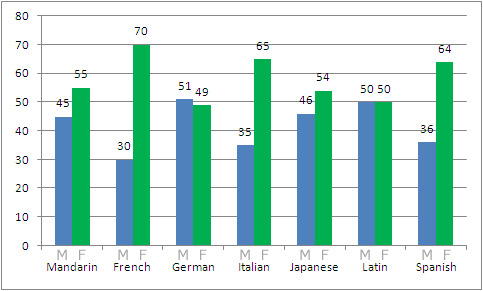2007 was the first year that the U.S. College Board offered an Advanced Placement (AP) exam for “Chinese Language and Culture.” It was also the first year students could take an AP exam in “Japanese Language and Culture.”
Data for the results as a whole have just been released. The figures for Mandarin are remarkably lopsided.
A total of 81.1 percent of those taking the exam for Mandarin and Chinese culture achieved the top score of 5, a much higher percentage than with any other test. The subject with the second highest percentage of 5’s was Japanese (43.4 percent), followed by Electricity and Magnetism (33.8 percent), Mechanics (26.1 percent), and German (24.4 percent). In most other subjects a score of 5 was achieved by only about 10 percent to 20 percent of test takers.
Let’s look at those who achieved only the lowest score (1). Here, too, Mandarin stands out, with by far the lowest percentage of test takers with this score (1.5 percent). Next are Drawing, 2-D Design, and 3-D Design (5.8 percent); English Language and Composition (10.9 percent); and Calculus BC (13.5 percent). Most subjects have “1” rates in the 20s.
Comparison of Scores Across Language Exams

Comparison of Lowest Scores Across Language Exams

So, does this indicate Mandarin isn’t damn hard for students after all or that the perfect pedagogy for this subject has been reached? Of course not.
Only 11.1 percent of the 3,260 people taking the Mandarin exam did not indicate on their test that they “regularly speak or hear the foreign language of the examination at home, or that they have lived for one month or more in a country where the language is spoken.”
Percent of test takers who “regularly speak or hear the foreign language of the examination at home” or “have lived for one month or more in a country where the language is spoken”

Thus, it’s no surprise to see that 89.4 percent of those taking the Mandarin exam identified themselves as “Asian, Asian American, or Pacific Islander.” Of all those across the entire United States who took the Mandarin exam last year, only 363 people did not identify themselves as falling within that category. This certainly does not match the hype about Mandarin as the foreign language being studied.
While I congratulate those who scored well on the exam (Chinese characters can certainly be a pain to learn regardless of your background), the test — and perhaps the curriculum, too — evidently needs considerable revision, which isn’t too surprising considering this was its first appearance. I’m a bit saddened, though, to see that more students from a wider variety of backgrounds aren’t taking up the challenge of Mandarin.
There doesn’t appear to be much of a gender imbalance, however, in AP Mandarin classes.
Percentages of students in AP language exams, by sex

Within a week or two I’ll be posting some interesting figures about U.S. post-secondary enrollments in Mandarin and other languages.
source: The 4th Annual AP Report to the Nation, College Board, February 13, 2008

When I took the Japanese SAT II way back in the day, it was wildly easy. All questions were written in both Japanese (kana + kanji) and r?maji. I don’t remember my exact score, but it was above 95%.
In addition to the phenomenon you describe of mostly Chinese speakers taking the tests, I believe it’s also the case that they have to set the bar low to begin with. The quality of secondary education foreign language programs is a total crapshoot. The vast majority of people who took Japanese at my high school ever achieved any real competency.
Then again, you can’t expect too much from a high school. Public schools are having a hard enough time keeping people up to speed in the basics, much less foreign languages.
I’d like to know the distribution of scores for the 11% of takers who were non-heritage speakers. Norming the test should be based on those results or else non-heritage speakers will be unlikely to study Mandarin.
Noonan: Here are the scores for the Mandarin exam’s “standard” group (i.e., those who did not state that they “regularly speak or hear the foreign language of the examination at home” and did not state that they “have lived for one month or more in a country where the language is spoken”).
Score of 5: 177 (48.8%)
Score of 4: 71 (19.6%)
Score of 3: 60 (16.5%)
Score of 2: 24 (6.6%)
Score of 1: 31 (8.5%)
For the sake of comparison, here are the breakdowns for the “standard” group for a couple other languages:
GERMAN:
Score of 5: 9.6%
Score of 4: 21.3%
Score of 3: 26.3%
Score of 2: 24.9%
Score of 1: 17.8%
FRENCH:
Score of 5: 7.4%
Score of 4: 14.9%
Score of 3: 31.7%
Score of 2: 22.7%
Score of 1: 23.3%
Given that nearly half of the standard group for Mandarin achieved top marks, while less than 10 percent of the standard groups for French and German did so, I would have to agree with Amake’s assessment: the bar appears to have been put far too low on the Mandarin exam.
A big worry when I was teaching Chinese and they first announced the Chinese AP was that colleges wouldn’t give any weight to the test because of native speakers taking it. This seems to confirm those fears.
Frankly, I doubt a Chinese AP will ever be much more than a way for native speakers to get a perfect test grade to show colleges. As Amake said, high school language teaching is a crapshoot, and very few people actually achieve competency without studying abroad. I think it’s even tougher with Chinese- 4th year high school Spanish classes can conceivably teach literature, but students are no where near that level in Chinese.
Also, given the sorry state Chinese teaching seems to be in in the US (at least at the places I’ve taught/ studied), looking at those scores I find it hard to believe that the AP was at all difficult.
We should try to track down a sample of the test. I am curious now
For sample questions, sound files, and a description of the the test and how it is graded, see the links on this page: Sample Questions & Scoring Guidelines.
Pingback: The Chinese AP Test in the United States « The Lingua Franca
Pingback: Pinyin news » US post-secondary enrollments in foreign languages and the position of Mandarin
Another possibility with the Mandarin and Japanese results versus the other language, is that possibly more of the students really want to be there learning them. I can see more students of French, German, Italian, etc., as taking those languages to fulfill a requirement of some sort and thus not really being fully with it.
This seemed to be the case with my Russian classes in High School anyway– there were many more Russian learners who wanted to be there than there were Spanish learners who wanted to be in their respective Spanish classes.
It may be that the bar was set wrong for these tests, but it may also be that people are highly driven to learn them. Being driven to learn something like that often produces impressive results.
I remember taking an admissions test at BCLU once where the task was to provide the pinyin of a list of characters. It did not take more than a minute for realization to dawn that the list was ordered… alphabetically.
I’d be curious to see the AP test myself. The HSK is at least a reasonable test of grammar and proficiency, although the emphasis on technical distinctions and nuance do not make it the best way to approach becoming conversationally fluent.
Pingback: Weekend Chinese Schools Win | Michael Erard
Pingback: Weekend Chinese Schools Win | Michael Erard